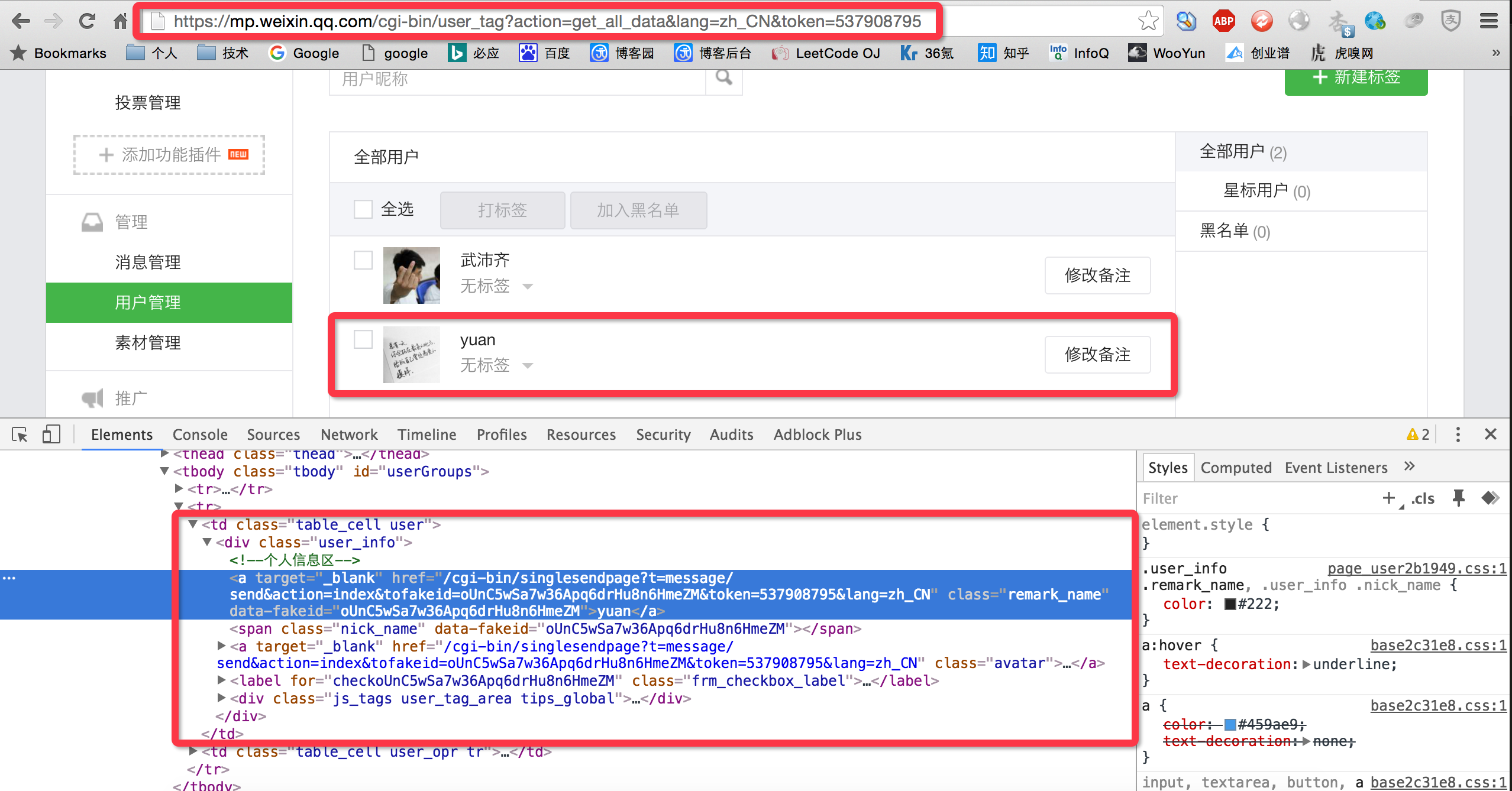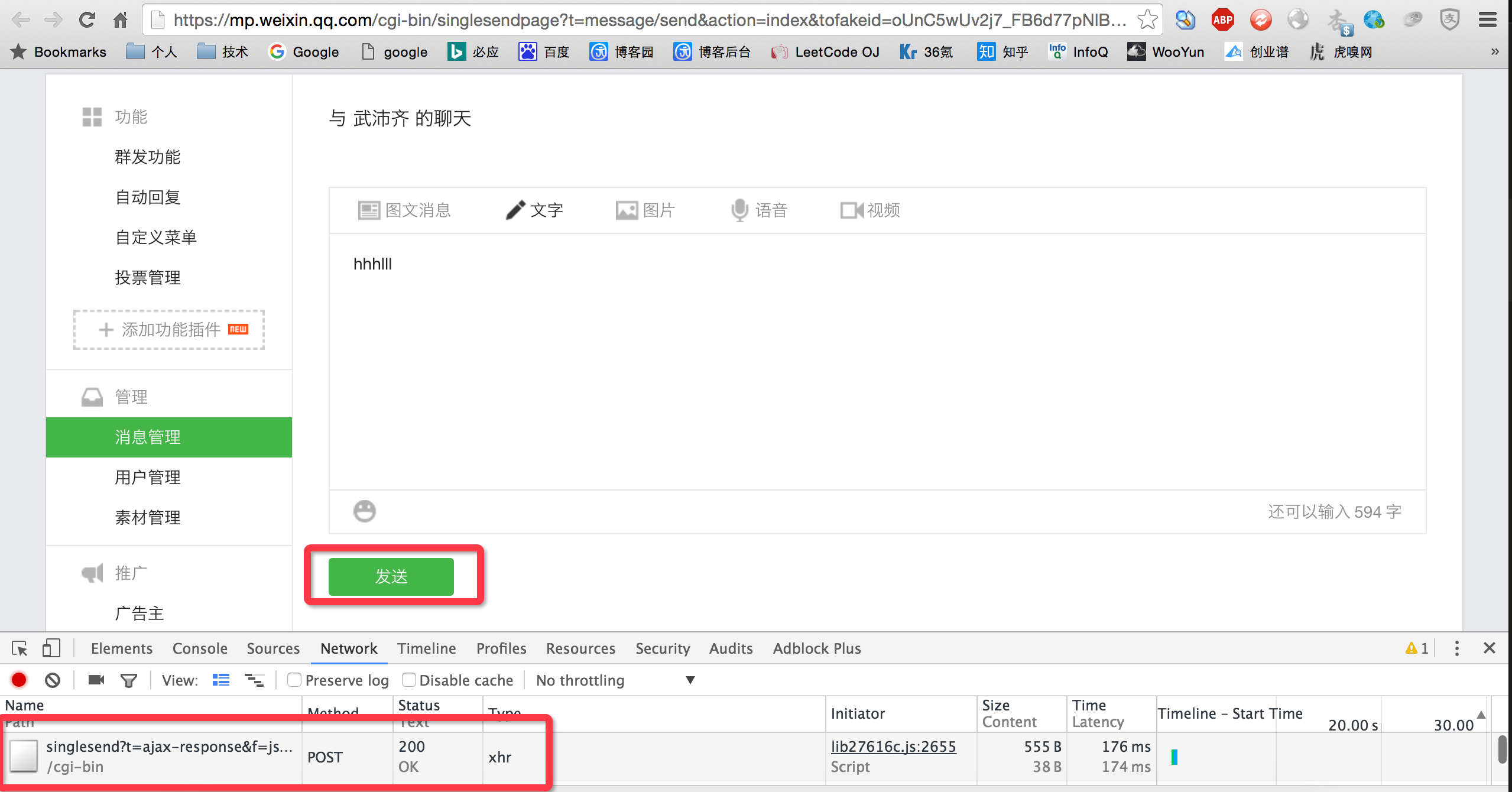网络爬虫(又被称为网页蜘蛛,网络机器人,在FOAF社区中间,更经常的称为网页追逐者),是一种按照一定的规则,自动地抓取万维网信息的程序或者脚本。另外一些不常使用的名字还有蚂蚁、自动索引、模拟程序或者蠕虫。
Requests
Python标准库中提供了:urllib、urllib2、httplib等模块以供Http请求,但是,它的 API 太渣了。它是为另一个时代、另一个互联网所创建的。它需要巨量的工作,甚至包括各种方法覆盖,来完成最简单的任务。
import urllib2
import json
import cookielib
def urllib2_request(url, method="GET", cookie="", headers={}, data=None):
"""
:param url: 要请求的url
:param cookie: 请求方式,GET、POST、DELETE、PUT..
:param cookie: 要传入的cookie,cookie= 'k1=v1;k1=v2'
:param headers: 发送数据时携带的请求头,headers = {'ContentType':'application/json; charset=UTF-8'}
:param data: 要发送的数据GET方式需要传入参数,data={'d1': 'v1'}
:return: 返回元祖,响应的字符串内容 和 cookiejar对象
对于cookiejar对象,可以使用for循环访问:
for item in cookiejar:
print item.name,item.value
"""
if data:
data = json.dumps(data)
cookie_jar = cookielib.CookieJar()
handler = urllib2.HTTPCookieProcessor(cookie_jar)
opener = urllib2.build_opener(handler)
opener.addheaders.append(['Cookie', 'k1=v1;k1=v2'])
request = urllib2.Request(url=url, data=data, headers=headers)
request.get_method = lambda: method
response = opener.open(request)
origin = response.read()
return origin, cookie_jar
# GET
result = urllib2_request('http://127.0.0.1:8001/index/', method="GET")
# POST
result = urllib2_request('http://127.0.0.1:8001/index/', method="POST", data= {'k1': 'v1'})
# PUT
result = urllib2_request('http://127.0.0.1:8001/index/', method="PUT", data= {'k1': 'v1'})
Requests 是使用 Apache2 Licensed 许可证的 基于Python开发的HTTP 库,其在Python内置模块的基础上进行了高度的封装,从而使得Pythoner进行网络请求时,变得美好了许多,使用Requests可以轻而易举的完成浏览器可有的任何操作。
1、GET请求
|
1
2
3
4
5
6
7
8
9
10
11
12
13
14
15
16
17
18
19
20
|
# 1、无参数实例import requestsret = requests.get('https://github.com/timeline.json')print ret.urlprint ret.text# 2、有参数实例import requestspayload = {'key1': 'value1', 'key2': 'value2'}ret = requests.get("http://httpbin.org/get", params=payload)print ret.urlprint ret.text |
向 https://github.com/timeline.json 发送一个GET请求,将请求和响应相关均封装在 ret 对象中。
2、POST请求
|
1
2
3
4
5
6
7
8
9
10
11
12
13
14
15
16
17
18
19
20
21
22
23
|
# 1、基本POST实例import requestspayload = {'key1': 'value1', 'key2': 'value2'}ret = requests.post("http://httpbin.org/post", data=payload)print ret.text# 2、发送请求头和数据实例import requestsimport jsonurl = 'https://api.github.com/some/endpoint'payload = {'some': 'data'}headers = {'content-type': 'application/json'}ret = requests.post(url, data=json.dumps(payload), headers=headers)print ret.textprint ret.cookies |
向https://api.github.com/some/endpoint发送一个POST请求,将请求和相应相关的内容封装在 ret 对象中。
3、其他请求
|
1
2
3
4
5
6
7
8
9
10
|
requests.get(url, params=None, **kwargs)requests.post(url, data=None, json=None, **kwargs)requests.put(url, data=None, **kwargs)requests.head(url, **kwargs)requests.delete(url, **kwargs)requests.patch(url, data=None, **kwargs)requests.options(url, **kwargs)# 以上方法均是在此方法的基础上构建requests.request(method, url, **kwargs) |
requests模块已经将常用的Http请求方法为用户封装完成,用户直接调用其提供的相应方法即可,其中方法的所有参数有:
def request(method, url, **kwargs):
"""Constructs and sends a :class:`Request <Request>`.
:param method: method for the new :class:`Request` object.
:param url: URL for the new :class:`Request` object.
:param params: (optional) Dictionary or bytes to be sent in the query string for the :class:`Request`.
:param data: (optional) Dictionary, bytes, or file-like object to send in the body of the :class:`Request`.
:param json: (optional) json data to send in the body of the :class:`Request`.
:param headers: (optional) Dictionary of HTTP Headers to send with the :class:`Request`.
:param cookies: (optional) Dict or CookieJar object to send with the :class:`Request`.
:param files: (optional) Dictionary of ``'name': file-like-objects`` (or ``{'name': ('filename', fileobj)}``) for multipart encoding upload.
:param auth: (optional) Auth tuple to enable Basic/Digest/Custom HTTP Auth.
:param timeout: (optional) How long to wait for the server to send data
before giving up, as a float, or a :ref:`(connect timeout, read
timeout) <timeouts>` tuple.
:type timeout: float or tuple
:param allow_redirects: (optional) Boolean. Set to True if POST/PUT/DELETE redirect following is allowed.
:type allow_redirects: bool
:param proxies: (optional) Dictionary mapping protocol to the URL of the proxy.
:param verify: (optional) whether the SSL cert will be verified. A CA_BUNDLE path can also be provided. Defaults to ``True``.
:param stream: (optional) if ``False``, the response content will be immediately downloaded.
:param cert: (optional) if String, path to ssl client cert file (.pem). If Tuple, ('cert', 'key') pair.
:return: :class:`Response <Response>` object
:rtype: requests.Response
Usage::
>>> import requests
>>> req = requests.request('GET', 'http://httpbin.org/get')
<Response [200]>
"""
# By using the 'with' statement we are sure the session is closed, thus we
# avoid leaving sockets open which can trigger a ResourceWarning in some
# cases, and look like a memory leak in others.
with sessions.Session() as session:
return session.request(method=method, url=url, **kwargs)
更多requests模块相关的文档见:http://cn.python-requests.org/zh_CN/latest/
自动登陆抽屉并点赞
|
1
2
3
4
5
6
7
8
9
10
11
12
13
14
15
16
17
18
19
20
21
22
|
### 1、首先登陆任何页面,获取cookiei1 = requests.get(url= "http://dig.chouti.com/help/service")### 2、用户登陆,携带上一次的cookie,后台对cookie中的 gpsd 进行授权i2 = requests.post( url= "http://dig.chouti.com/login", data= { 'phone': "86手机号", 'password': "密码", 'oneMonth': "" }, cookies = i1.cookies.get_dict())### 3、点赞(只需要携带已经被授权的gpsd即可)gpsd = i1.cookies.get_dict()['gpsd']i3 = requests.post( url="http://dig.chouti.com/link/vote?linksId=8589523", cookies={'gpsd': gpsd})print(i3.text) |
“破解”微信公众号
“破解”微信公众号其实就是使用Python代码自动实现【登陆公众号】->【获取观众用户】-> 【向关注用户发送消息】。
注:只能向48小时内有互动的粉丝主动推送消息
1、自动登陆

分析对于Web登陆页面,用户登陆验证时仅做了如下操作:
- 登陆的URL:https://mp.weixin.qq.com/cgi-bin/login?lang=zh_CN
- POST的数据为:
{
'username': 用户名,
'pwd': 密码的MD5值,
'imgcode': "",
'f': 'json'
}
注:imgcode是需要提供的验证码,默认无需验证码,只有在多次登陆未成功时,才需要用户提供验证码才能登陆 - POST的请求头的Referer值,微信后台用次来检查是谁发送来的请求
- 请求发送并登陆成功后,获取用户响应的cookie,以后操作其他页面时需要携带此cookie
- 请求发送并登陆成功后,获取用户相应的内容中的token

# -*- coding:utf-8 -*-
import requests
import time
import hashlib
def _password(pwd):
ha = hashlib.md5()
ha.update(pwd)
return ha.hexdigest()
def login():
login_dict = {
'username': "用户名",
'pwd': _password("密码"),
'imgcode': "",
'f': 'json'
}
login_res = requests.post(
url= "https://mp.weixin.qq.com/cgi-bin/login?lang=zh_CN",
data=login_dict,
headers={'Referer': 'https://mp.weixin.qq.com/cgi-bin/login?lang=zh_CN'})
# 登陆成功之后获取服务器响应的cookie
resp_cookies_dict = login_res.cookies.get_dict()
# 登陆成功后,获取服务器响应的内容
resp_text = login_res.text
# 登陆成功后,获取token
token = re.findall(".*token=(d+)", resp_text)[0]
print resp_text
print token
print resp_cookies_dict
login()
登陆成功获取的相应内容如下:
|
1
2
3
4
5
|
响应内容:{"base_resp":{"ret":0,"err_msg":"ok"},"redirect_url":"/cgi-bin/home?t=home/index&lang=zh_CN&token=537908795"}响应cookie:{'data_bizuin': '3016804678', 'bizuin': '3016804678', 'data_ticket': 'CaoX+QA0ZA9LRZ4YM3zZkvedyCY8mZi0XlLonPwvBGkX0/jY/FZgmGTq6xGuQk4H', 'slave_user': 'gh_5abeaed48d10', 'slave_sid': 'elNLbU1TZHRPWDNXSWdNc2FjckUxalM0Y000amtTamlJOUliSnRnWGRCdjFseV9uQkl5cUpHYkxqaGJNcERtYnM2WjdFT1pQckNwMFNfUW5fUzVZZnFlWGpSRFlVRF9obThtZlBwYnRIVGt6cnNGbUJsNTNIdTlIc2JJU29QM2FPaHZjcTcya0F6UWRhQkhO'} |
2、访问其他页面获取用户信息

分析用户管理页面,通过Pyhton代码以Get方式访问此页面,分析响应到的 HTML 代码,从中获取用户信息:
- 获取用户的URL:https://mp.weixin.qq.com/cgi-bin/user_tag?action=get_all_data&lang=zh_CN&token=登陆时获取的token
- 发送GET请求时,需要携带登陆成功后获取的cookie
1{'data_bizuin':'3016804678','bizuin':'3016804678','data_ticket': 'C4YM3zZ... - 获取当前请求的响应的html代码
- 通过正则表达式获取html中的指定内容(Python的模块Beautiful Soup)
- 获取html中每个用户的 data-fakeid属性,该值是用户的唯一标识,通过它可向用户推送消息

# -*- coding:utf-8 -*-
import requests
import time
import hashlib
import json
import re
LOGIN_COOKIES_DICT = {}
def _password(pwd):
ha = hashlib.md5()
ha.update(pwd)
return ha.hexdigest()
def login():
login_dict = {
'username': "用户名",
'pwd': _password("密码"),
'imgcode': "",
'f': 'json'
}
login_res = requests.post(
url= "https://mp.weixin.qq.com/cgi-bin/login?lang=zh_CN",
data=login_dict,
headers={'Referer': 'https://mp.weixin.qq.com/cgi-bin/login?lang=zh_CN'})
# 登陆成功之后获取服务器响应的cookie
resp_cookies_dict = login_res.cookies.get_dict()
# 登陆成功后,获取服务器响应的内容
resp_text = login_res.text
# 登陆成功后,获取token
token = re.findall(".*token=(d+)", resp_text)[0]
return {'token': token, 'cookies': resp_cookies_dict}
def standard_user_list(content):
content = re.sub('s*', '', content)
content = re.sub('
*', '', content)
data = re.findall("""cgiData=(.*);seajs""", content)[0]
data = data.strip()
while True:
temp = re.split('({)(w+)(:)', data, 1)
if len(temp) == 5:
temp[2] = '"' + temp[2] + '"'
data = ''.join(temp)
else:
break
while True:
temp = re.split('(,)(w+)(:)', data, 1)
if len(temp) == 5:
temp[2] = '"' + temp[2] + '"'
data = ''.join(temp)
else:
break
data = re.sub('*d+', "", data)
ret = json.loads(data)
return ret
def get_user_list():
login_dict = login()
LOGIN_COOKIES_DICT.update(login_dict)
login_cookie_dict = login_dict['cookies']
res_user_list = requests.get(
url= "https://mp.weixin.qq.com/cgi-bin/user_tag",
params = {"action": "get_all_data", "lang": "zh_CN", "token": login_dict['token']},
cookies = login_cookie_dict,
headers={'Referer': 'https://mp.weixin.qq.com/cgi-bin/login?lang=zh_CN'}
)
user_info = standard_user_list(res_user_list.text)
for item in user_info['user_list']:
print "%s %s " % (item['nick_name'],item['id'],)
get_user_list()
3、发送消息

分析给用户发送消息的页面,从网络请求中剖析得到发送消息的URL,从而使用Python代码发送消息:
- 发送消息的URL:https://mp.weixin.qq.com/cgi-bin/singlesend?t=ajax-response&f=json&token=登陆时获取的token放在此处&lang=zh_CN
- 从登陆时相应的内容中获取:token和cookie
- 从用户列表中获取某个用户唯一标识: fake_id
- 封装消息,并发送POST请求
1234567891011send_dict={'token': 登陆时获取的token,'lang':"zh_CN",'f':'json','ajax':1,'random':"0.5322618900912392",'type':1,'content': 要发送的内容,'tofakeid': 用户列表中获取的用户的ID,'imgcode': ''}

# -*- coding:utf-8 -*-
import requests
import time
import hashlib
import json
import re
LOGIN_COOKIES_DICT = {}
def _password(pwd):
ha = hashlib.md5()
ha.update(pwd)
return ha.hexdigest()
def login():
login_dict = {
'username': "用户名",
'pwd': _password("密码"),
'imgcode': "",
'f': 'json'
}
login_res = requests.post(
url= "https://mp.weixin.qq.com/cgi-bin/login?lang=zh_CN",
data=login_dict,
headers={'Referer': 'https://mp.weixin.qq.com/cgi-bin/login?lang=zh_CN'})
# 登陆成功之后获取服务器响应的cookie
resp_cookies_dict = login_res.cookies.get_dict()
# 登陆成功后,获取服务器响应的内容
resp_text = login_res.text
# 登陆成功后,获取token
token = re.findall(".*token=(d+)", resp_text)[0]
return {'token': token, 'cookies': resp_cookies_dict}
def standard_user_list(content):
content = re.sub('s*', '', content)
content = re.sub('
*', '', content)
data = re.findall("""cgiData=(.*);seajs""", content)[0]
data = data.strip()
while True:
temp = re.split('({)(w+)(:)', data, 1)
if len(temp) == 5:
temp[2] = '"' + temp[2] + '"'
data = ''.join(temp)
else:
break
while True:
temp = re.split('(,)(w+)(:)', data, 1)
if len(temp) == 5:
temp[2] = '"' + temp[2] + '"'
data = ''.join(temp)
else:
break
data = re.sub('*d+', "", data)
ret = json.loads(data)
return ret
def get_user_list():
login_dict = login()
LOGIN_COOKIES_DICT.update(login_dict)
login_cookie_dict = login_dict['cookies']
res_user_list = requests.get(
url= "https://mp.weixin.qq.com/cgi-bin/user_tag",
params = {"action": "get_all_data", "lang": "zh_CN", "token": login_dict['token']},
cookies = login_cookie_dict,
headers={'Referer': 'https://mp.weixin.qq.com/cgi-bin/login?lang=zh_CN'}
)
user_info = standard_user_list(res_user_list.text)
for item in user_info['user_list']:
print "%s %s " % (item['nick_name'],item['id'],)
def send_msg(user_fake_id, content='啥也没发'):
login_dict = LOGIN_COOKIES_DICT
token = login_dict['token']
login_cookie_dict = login_dict['cookies']
send_dict = {
'token': token,
'lang': "zh_CN",
'f': 'json',
'ajax': 1,
'random': "0.5322618900912392",
'type': 1,
'content': content,
'tofakeid': user_fake_id,
'imgcode': ''
}
send_url = "https://mp.weixin.qq.com/cgi-bin/singlesend?t=ajax-response&f=json&token=%s&lang=zh_CN" % (token,)
message_list = requests.post(
url=send_url,
data=send_dict,
cookies=login_cookie_dict,
headers={'Referer': 'https://mp.weixin.qq.com/cgi-bin/login?lang=zh_CN'}
)
get_user_list()
fake_id = raw_input('请输入用户ID:')
content = raw_input('请输入消息内容:')
send_msg(fake_id, content)
以上就是“破解”微信公众号的整个过程,通过Python代码实现了自动【登陆微信公众号平台】【获取用户列表】【指定用户发送消息】。